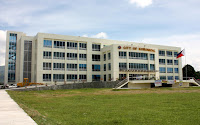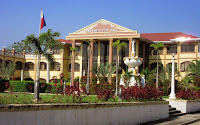History
There are twenty three (23) Barangay comprising the City with a total land area of 18,568 hectares Gapan to Manila is aproximity 96 kilometers and 19 kilometers from Cabanatuan City.
The city of Gapan is one of the component cities of Nueva Ecija today that is at the forefront of the national effort to insure social and economic advancement. Gapan is now considered as the footwear capital of the north. Also it is an inseparable part of the Rice Granary of the Philippines.
Gapan was organized by the Spanish curates and officials who in their early occupation, exercised great influence over the people and the things they were doing, History places Gapan as one of the first towns of Pampanga founded sometime in the middle part of the sixteenth century. Records of the first Catholic Mission to the fareast indicated that in 1595 Fathers Contreas Tendilla, Caballo and Salazar were responsible for clearing the forest which later became a Pueblo. In this Pueblo were constructed a church, presidencia and residential houses made of bricks and lime constituted age old Landmarks of the town.
Historical data recorded that Gapan was founded in 1595 making it the oldest town in Nueva Ecija and one of the oldest in the Philippines. It was likewise a big Pueblo embracing an area as far as Cabanatuan City in the north, which was its barrio with the name Cabanatuan before it separated in 1777: the Sierra Madre in the East, San Miguel, Bulacan in the South and Candaba, Pampanga in the West. Gradually as the Spanish power waned an economic progress caught up in the area, the pueblo disintegrated into many pueblos until it remained to comprise only the towns of Penaranda, General Tinio and San Leonardo ( formerly called Manikling) all of Nueva Ecija province. In fact the Patron Saint Divina Pastora had its origin or residence in Barrio Callos. Penaranda.
Extant record had this town called “Ibon†and how to come to be known as Gapan has its interesting legend it has already been intimated that this place was formerly a wilderness. At a time it was so, some Spanish soldier on certain mission came here when they saw natives crawling through the thick bushes .The soldier halted them and not knowing the local dialect asked in Spanish for the name of the town. The natives know nothing of the Spanish Language and thinking that the Spanish were asking what they were doing answered in Tagalog a local dialect “Gumagapang gapang kami†The Spanish took it as a name and henceforth called The Pueblo Gapang. In due time, the letter “g†was dropped and the more finesse name Gapan stick to this day. Another legend stated the name came from the climbing and crawling plants that were so numerous in the locality.
Originally, the town had eight barrios namely, Sta Cruz, Mangino, Pambuan, San Lorenzo, San Vicente, San Nicolas, Sto Cristo and San Roque or Baluarte, with San Lorenzo and San Vicente constituting the poblacion of the Municipality. Thirteen additional Barrios or Barangay were established by then Municipal council or under the charter and they are Bungo, Kapalangan, Puting Tubig, Makabaklay,Maburak Sto Nino, Bayanihan, Sto Cristo Norte, Malimba, Mahipon, Bulak, Parcutela and Marelo.
The Church of Gapan is made of Bricks, Adobe and Lime. The architecture is Byzantine and was constructed under the successive direction and supervision of Father Loredo,Conejo and Llaneza for a period of about sixteen years, that is 1856-1872. Like most of gigantic building done during the Spanish regime, the church was built through forced labor. The materials used were taken from Laryuhan in Barrio San Vicente and from Barrio San Lorenzo near Pambuan to bring the material to the site of the church, laborers had to line themselves straight between the sources of materials and site of construction and had to pass the bricks from one hand to another. Records show that since 1740, Gapan has “ Cura Parrocos†beginning with father Francisco Medalla. Hence it is also right to assess that the Catholic Church of Gapan is now over two centuries old.
The City has two Patron Saints, the Three Kings and the Divine Shepherdess. The feast for the Three Kings is every sixth day of January and the Divine Shepherdess is every first of May, these was the Official City Fiesta as declared by then municipal council by an ordinance. This fact accounted for Gapan City to become a place of Pilgrimage for devotees in Central Luzon The miracles of the Divine Shepherdess has attracted the attention of the church authorities that on April 26, 1964, she was crown queen at the church plaza thereby making Gapan an official pilgrimage city where her graces would flourish for those who visit Gapan in the same manner that the Virgin of good voyage would lavish for those who go on pilgrimage to Antipolo City.
One of the eight rays in the Filipino flag represent Nueva Ecija as one of the eight provinces which took up arms against Spain, participants in this uprising came from Gapan, San Isidro, Cabiao and Penaranda led by General Pantaleon Valmonte ( mentioned as Belmonte in history ) Gapan contributed thirteen heroes of martyr killed by the Spaniards They were Epifanio Ramos, Quintin Tinio, Faustino Delos Reyes, Leocadia Liwag, Valentin Liwag, Severino Changco, Saturnino Magno and Ramon Tinawin .In due recognition of their patriotic sacrifices Gapan City government had given due honors by erecting a monument at the San Vicente Plaza called “Inang Bayan†where their names were engraved and by naming the streets in the city proper after them.
The City of Gapan acquired corporate existence in the ratification of its creation by a majority of votes cast by the qualified voters in a plebiscite conducted last August 25, 2001. By virtue of Republic Act no. 9022 sponsored by Congresswoman Julita Lorenzo Villareal, Gapan was converted into a component city.
The City of Gapan held tremendous promise not only in its natural resources but also in its potentials in agri-base industries and in footwear industries which help sustain its vital role in agricultural and industrial production. Commercial and trade activities in the city are further accelerated by the influx of financial lending institution and new businesses
City of Gapan is located in the South Eastern part of Nueva Ecija. It is bounded on the North by the Municipality of San Leonardo, on the East by the municipalities of Penaranda and Gen. Tinio, on the West by the Municipalities of San Isidro and Candaba, Pampanga, on the South by the Municipality of San Miguel, Bulacan.











































































































































